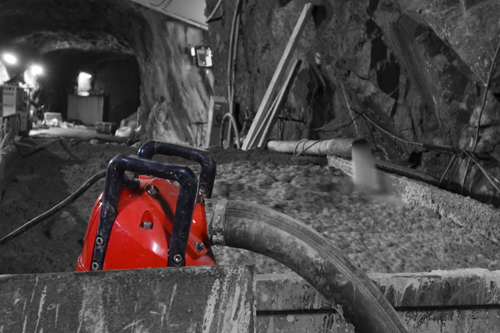
Grindex was founded in 1940 by two Swedish engineers. Among its earliest products was a rock grinding machine: this established the firm in the mining and construction markets; however when co-founder Börje Kristensson was out selling the grinding machine, he came across a new product on the market, a submersible drainage pump. The problem with submersible pumps in the early 1960s was that they were heavy and could not run dry. Kristensson set about developing a lightweight pump that could run dry, thanks to a patented air valve.
The rest, as they say, is history. Grindex retained its name, but by the 1980s sold the grinding machine business and positioned itself as a specialist in dewatering pumps for many applications. Today the company is a global leader in submersible pumps for demanding applications such as construction, mining and rental. Grindex products are exported all around the world through more than 50 regional distributors.
In 1989 Grindex set up a USA subsidiary in Chicago. The company’s current Managing Director Per Rehn went out there in 2009, two years after he joined the company, to manage a strategic expansion into the Canadian market. Having overseen the growth of sales in North America in the course of two years, he returned to Sweden where he now heads the global activities of Grindex AB.
The year 2008 saw a major restructuring of the company. “At that time it was decided to optimise the synergies between the different specialist pump manufacturers in the ITT group and to develop a platform upon which to develop the Grindex range along with others within the corporation,” says Rehn. This reduced the amount of overlap within the group’s product ranges, as well as introducing the sound automotive industry principle of utilising common components wherever possible.
The company closed its old office and moved to new premises in Stockholm. At the same time the manufacturing facilities were rationalised as well. Grindex closed its Stockholm factory and moved production to an extended manufacturing facility at Emmaboda in the Småland district of southern Sweden, with dedicated lines for the Grindex ranges. Divested of the need to run a manufacturing facility Grindex now concentrates on its sales, marketing and logistics functions and on extending its reach in overseas markets.
The new set up has been very beneficial for Grindex’s sales, its top line growing from SEK 210 million, or around $33 million in 2009, to SEK 332 million in 2012 – a little over $50 million. It will be observed that the growth in business both in the USA and globally under Rehn’s watch was achieved in the face of a global recession. However he is quick to admit that it was helped by the fact that the mining sector, one of the principal applications for the range, has expanded as softer markets have contracted.
The company, leaner after its reorganisation, retains the key advantages that established the brand. “Having been in the market since the 1960s we have a legacy of satisfaction from our customers, and of knowledgeable, experienced people working in the company.” This legacy has positioned Grindex as one of the very few truly global brands, its major competitors the Japanese manufacturer Tsurumi and ABS pumps, recently acquired by Sulzer.
In 2011 the water management businesses within the ITT group were combined and the new group was named Xylem – as every schoolchild should know, xylem are the water-raising filaments in trees and plants!
To illustrate the power of Grindex pumps when faced with a really challenging problem, one of the best examples comes not from Africa or Asia, but on Grindex’s doorstep in Sweden, says Rehn. In 2011 the locks of the Trollhättan canal in central Sweden needed to be upgraded, and new gates installed. Each lock can accommodate ships up to 4,000 tonnes: they are 89 metres in length, 13 metres wide and 5.4 metres deep and hold more than 6,000 cubic metres of water. Four locks needed emptying, so powerful and reliable pumps that could operate around the clock were essential.
Staff from Grindex’s technical department assisted the contractor Sjuntorps Industri Support AB with the sizing of the pumps. With 37 million litres of water to be drained before work could get started, three slurry pumps, 22 drainage pumps and a sludge pump were recommended. After 25 days the project was successfully completed and the canal re-opened to shipping: the pumps were given a standard service and put back into storage awaiting the next rental project.
Mining companies are now increasingly turning to Grindex to cope with harsh conditions underground. In the largest underground copper mine in the world in Chile, Grindex Inox pumps able to pump 50 litres per second paid for themselves within months when installed to replace conventional end-suction pumps that were pumping only 15 litres per second and had spare part availability problems. The mine needed to reclaim copper from the water rather than just send it to the treatment plant. Grindex's exclusive distributor for the Chilean market, Santiago-based ACH, provides a maintenance contract where the pumps are pulled out for preventive maintenance every 2,000 hours and replaced by stand-in pumps. The preventive maintenance avoids unscheduled stops and more expensive repairs and the total maintenance cost is cut drastically.
To keep up not just with the volume growth in mining but also its geographical expansion, Per Rehn wants to refocus his team and his resources onto emerging markets. This approach has paid off in Latin America through hiring people resident in Sweden but born and raised in Central and South America. “They are versed in the culture, know the local languages and understand the way business is done in these markets. I think local knowledge of this sort is very important if you want to build a good relationship with the mine management.”
There are Australian, Russians and people from South Africa in Grindex working alongside local distributors to penetrate these markets. “It is our strategy to make full use of distributors in most of our markets – we do not have our own sales teams in the field except in USA and even there we appoint regional distributors too.” Appointing a distributor is a long-term commitment, he adds. “We consider ourselves very entrepreneurial, and we like to encourage a similar spirit in our distributors. In response we try to listen to them and respond in a flexible way when they suggest improvements, something they appreciate.”
Written by John O'Hanlon, research by Marcus Lewis
DOWNLOAD
 Grindex-Euro-Mining-Aug13-Bro-s.pdf
Grindex-Euro-Mining-Aug13-Bro-s.pdf













